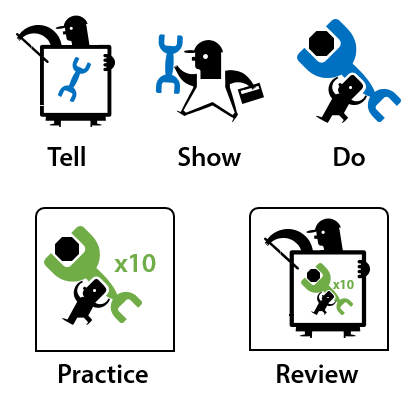
I was chatting with someone recently who was complaining that the organization’s e-learning courses weren’t successful. After some conversation, it turns out that the courses were mostly information-based courses. The organization did a great job pulling content together, but outside of the content (and some nice looking slides) there wasn’t much to the courses.
We talked a bit more about what it takes for a training course to be successful.
Successful Training Defines Success
There are different reasons why organizations create e-learning courses. And with that, the measure of success various. Many courses have no performance expectations tied to their e-learning courses. They’re mostly information that needs to be shared for one reason or another. And often the learner has no control over whether or not to take the course because they’re mandatory (and usually not relevant or applicable to the learner).
That’s why I usually sort courses into one of two buckets: information or performance. A course without performance expectations has fuzzy metrics and no clear understanding of success.

Another consideration is the before and after gap. The learner (or organization) is at point X and I need to get them to point Y. For this to happen, I need to understand the difference between X and Y and why the learner isn’t currently at Y.
Why is there a gap? Sometimes the gap is training-related, but often it isn’t. It doesn’t help to build training to close a gap that isn’t cause by a deficiency in training. The challenge is getting your client or subject matter expert to see that.
For this post, we’ll assume that the course you’re building has clearly defined performance goals.
Successful Training Needs the Right Content
Successful training focuses on the right content to meet specific goals. We usually have plenty of content. If you have a problem I have some information to help. That’s good. However, sometimes we have too much information and the gap in training usually isn’t lack of information, especially in this day and age of instant access to everything.

What are the objectives and what do they need to be able to do to meet them? And what information do they need to know to be able to do what they need to do? That’s the content you need. Of course, the challenge is getting your client to see that they don’t need all 300 PowerPoint slides in the course.
Successful Training Provides Practice & Feedback
Having the right content is part of it, but for people to learn they need to practice applying what they learn in the course to relevant situations. How will they use the learning at work and when?
I see a lot of courses that skip relevant practice activities and use simple multiple choice quizzes. In some cases, simple quiz questions work, especially when they’re built around a case study. However, they usually don’t do more than assess the person’s recall of the content. And for performance-related courses, this is not adequate.

When you do create the activities keep in mind that they can be inside or outside of the course. I’ve worked on projects where we streamlined the presentation of information in an e-learning module and then built practice activities with peer coaches on the floor. In either case, successful training focuses on relevant practice activities. Remember: Tell, Show, Do, Practice & Review!
Successful Training Demonstrates Understanding & Skills
The ultimate goal of the course shouldn’t be completion. Instead it’s learner’s ability to meet the organization’s performance goals. The course is just a means to get them to that point. Again, we’re trying to span that gap from X to Y.
The goal is to get them to demonstrate their understanding & skills related to the training. We do this by focusing on relevant content and getting them to practice applying what they learn to real world situations. Then we provide the feedback that helps them make the appropriate adjustments.
One serious challenge many of us have is that success is define by course completion and an end-of-year report from the learning management system. Of course we want people to complete the course. But a completed course means little if the organization isn’t meeting its goals. We need changed behavior or improved performance.
Often this is difficult for those of us who build e-learning courses because we don’t have access to the metrics or level of management to really know if what we build has been effective. In that case here are two pieces of advice:
- Get a seat at the table. Don’t sit passively taking e-learning orders. Learn more about the organization’s objectives and be proactive in finding ways to use your skills to help them get there. You’ll be seen as an ally and have some influence on training expectations.
- Measure what you can. If you don’t have access to performance metrics, you need to find other ways to measure how what you’re doing contributes to success. You may contribute by lower production costs or asynchronous access to the content (which lowers travel costs and create more flexible learning opportunities). Build relevant practice activities so you can at least state that during the practice activities the learner demonstrated understanding and skills required for success.
Successful Training Includes Successful Learners
You can build a great course, but you can’t control the person taking the course. Their motivation and commitment to the course plays a big role in your success. While you can’t control their motivation and attitude there are things you can do to frame a perspective of the course that is more beneficial. Here are a few:
Obviously there are a lot more things you can do. The key point is that while you can’t control the person’s disposition towards the course, you can influence it in how it’s built and presented to them. Ultimately, the goal is that they can apply what they’re learning to the real world and demonstrate their understanding and changed behavior.
The e-learning courses we build are only one part of what makes successful training. It also requires crafting objectives tied to real performance expectations and creating courses that are interesting, and engaging, as well as effective.
What advice do you have for someone who wants to create successful e-learning?
Events
Free E-Learning Resources



















0
comments